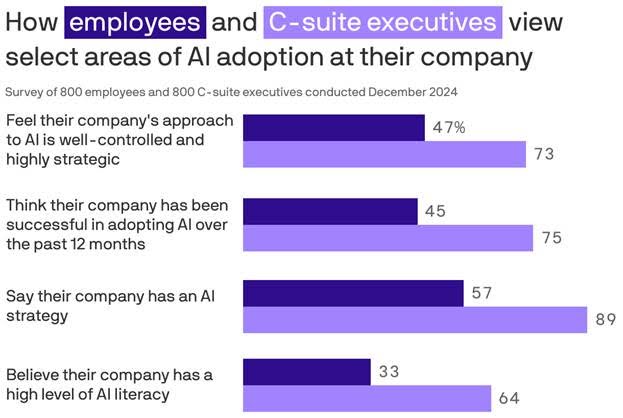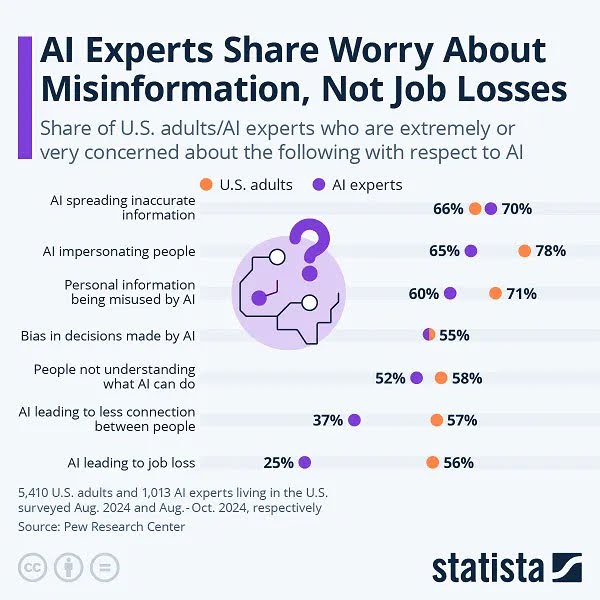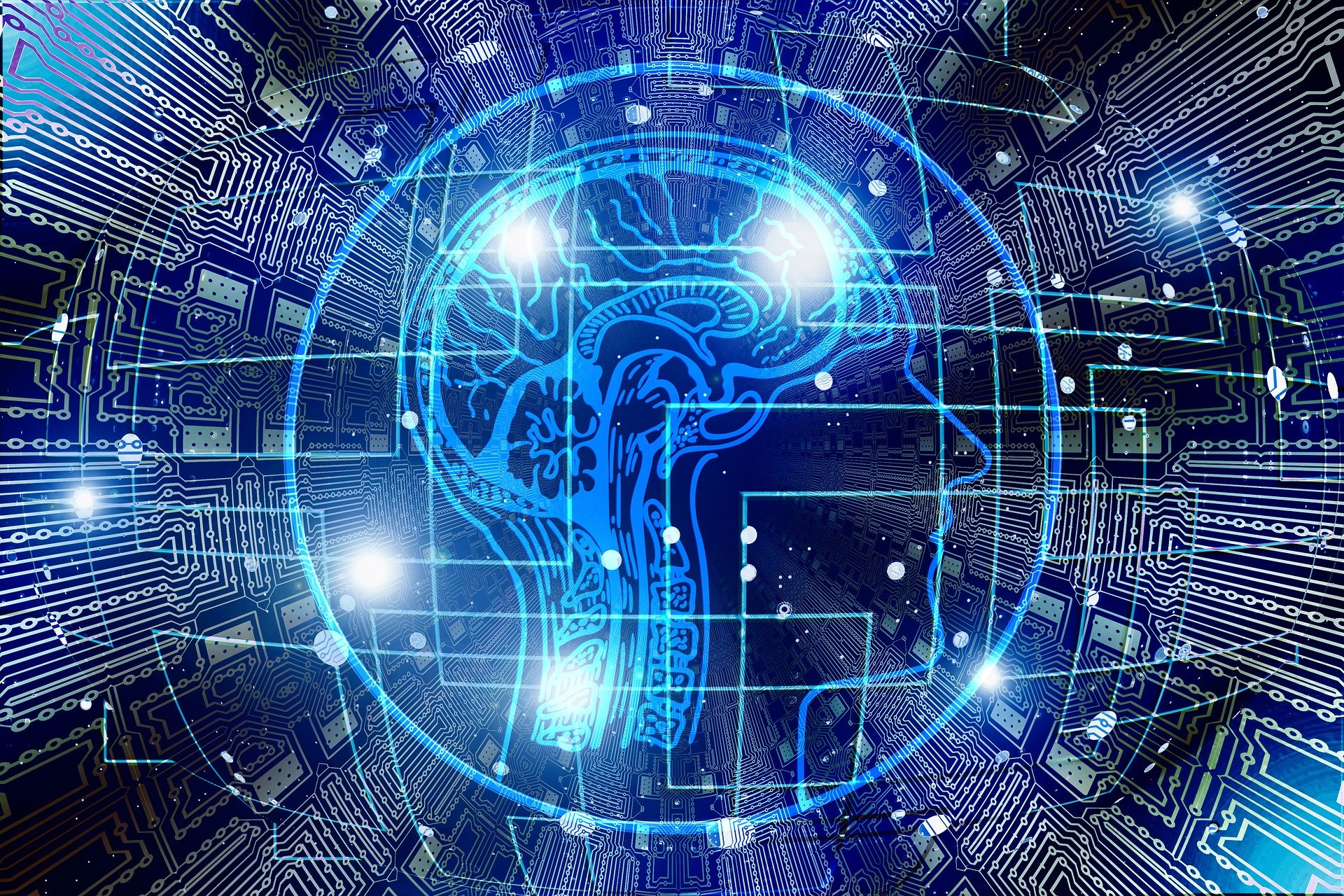Today’s employees have a litany of concerns, including the impact of tariffs, a slowing job market, and the risk of a “white collar recession.” But their biggest source of angst is generative artificial intelligence (AI).
How will AI impact their current role? Will it make their job obsolete? What trends should they be watching? Workers have lots of questions—and worries—about the impacts of AI.
Most impactfully, what should corporate leaders be doing to mitigate employee concerns and make sure AI has a positive impact on their workplace culture and bottom line?
As recently noted in a Wired magazine piece, a pressing concern of workers and employers alike is “how today’s generative AI tools will transform the labor market. Some experts envisage a world of increased productivity and job satisfaction; others, a landscape of mass unemployment and social upheaval.”1
This post delves into the potential impacts of AI on the workplace and job market; how perspectives differ among business leaders, workers, and AI experts; and what actions leaders should be taking in order to reassure employees and get the most out of their AI investments.
The Current State of the Job Market
The current job market is a bit of a muddle for unemployed job seekers as well as workers looking to make a change. The Tampa Bay Business Journal reported that:
“For job seekers and employers, 2025 is shaping up to (be) neither too hot nor too cold, but somewhere in a lukewarm middle…Absent a meaningful uptick in job openings and postings, finding a job could be trickier in 2025 than it was during the hiring surge of 2021 and 2022, especially in knowledge-work sectors where employer demand remains low.”2
Not surprisingly, more workers are staying put, effectively turning the “great resignation” of early 2022 into the “great stay” of 2025.
“The American Staffing Association…found in a recent survey 40% of unemployed job seekers have not had a single interview in the past 12 months (even as) 42% of unemployed job seekers applied to 10 or more jobs this year.”
Furthermore, “Unemployment crept up…from 3.7% in 2022 to a high of 4.3%” in the summer of 2024. “This has translated to a daunting job search for many workers. According to Pathrise, a career-guidance company, it took white-collar workers an average of 294 job applications to land a job…It also took an average of 247 days (eight months!) to land a job in 2024.”2
“The overall separation rate of employees — who quit, are fired or are laid off — has stayed relatively steady, at about 3.3%, for more than a year, according to a separate report by the BLS. The layoff rate has also been stable, hovering near record lows.”3
While economic uncertainty is the primary culprit keeping businesses from expanding their payrolls, AI is beginning to play a role as well, though its effects are mixed.
The Negative Impacts of AI on the Job Market
AI is beginning to have a mix of effects on the job market, from the pace of hiring to the terrain job seekers must navigate. It’s impacting new employment prospects at all levels, from management to gig workers.
At the high end, “The corporate world is getting flatter, as more companies look to get rid of managers.”4 To some extent, AI is accelerating the movement toward flatter organizations through the potential to automate routine managerial tasks such as report generation, data analysis, and scheduling.
Additionally, “64% of managers said their employees are worried AI tools will make them less valuable at work, while 58% of managers said their employees are worried AI tools will eventually cost them their jobs.”7
At the corporate employee level, concerns about job loss and a more challenging job market are increasing—and backed by research. “Americans also continue to remain worried about AI being used as justification to lay them off. About 52% in a survey by Monster.com said they were worried AI could eventually replace their jobs.
“A separate 2024 survey found 41% of 3,000 American managers by Beautiful.ai said they were hoping to replace employees with cheaper AI tools.”6 Another study found that AI will affect nearly 40% of jobs, replacing some and complementing others.
Yet another study found that, “while 52% of human-resources executives surveyed said they have no plans to replace workers with AI in the near future, 18% said they were currently working to replace workers with AI and 20% said they were considering doing so.”3
According to AtWork Group, “AI is a game changer, but its true impact on the job market hasn’t yet been felt. We still haven’t seen jobs go ‘extinct’ because of it, but we see areas of opportunity where this may be the case, and people are starting to take note.”5
AI is even negatively impacting the job market for gig workers and freelancers. “The proliferation of those tools has caused many freelance gigs to evaporate and is also prompting companies to hire workers with AI skills or training.
“A study recently published in the Harvard Business Review that tracked gig postings on a major freelance platform found a 21% drop in automation-prone jobs related to writing and coding after the mainstream introduction of ChatGPT in late 2022. The study also found a 17% drop in the number of job postings related to image creation…
“A separate study from consulting and accounting firm Kruse…found an 85% drop in outsourced marketing spending (among startups) between November 2022, when ChatGPT was widely introduced, to August 2024.”9
Positive News About the Job Market
Not all of the news about AI and the job market is doom and gloom. Some of the concerns about the negative impacts of AI, at least in the short term, appear to be overblown.
According to Mary Daly, CEO of the San Francisco Federal Reserve, “Some (firms) are going to have more opportunities to replace workers, and some more to augment, but overall what I’m seeing is that no firm is using it as a replacement tool alone.”1
The data indicates that fears of a “white-collar recession” may be excessive as well. Per Noah Yasif of the American Staffing Association:
“Over the past year, even as the job market has slowed and job openings have fallen, the number of employees in white-collar work grew by 1.4%, more than twice that of blue-collar occupations…In industries where white-collar occupations comprise more than half the workforce, job openings grew by 2.3%.”5
In other words, the growth rate of white-collar job openings has slowed—but opportunities are still expanding.
Finally, while AI will almost certainly come for a range of jobs eventually, most roles are safe for the foreseeable future. A “study by Indeed of 2,800 job skills found that 68.7% of skills were classified as ‘very unlikely’ or ‘unlikely’ to be replaced by AI, while 28.5% could potentially be replaced by AI — and none were ‘very likely’ to be replaced by AI anytime soon.”5
The Negative Impacts of AI in the Workplace
As with worries about the job market, AI is causing concerns across levels within enterprises. Among leadership, “44% of managers said they are fearful that AI tools in the workplace will result in lower pay for workers in management positions…
“Managers are clearly worried about AI tools…64% of managers say AI outputs are on par with outputs from a ‘novice manager,’ a 28% increase over 2024, and 41% of managers believe AI tools are a threat to their own pay and will fuel wage declines across the country this year.”7
Corporate employees generally are concerned about AI taking their jobs—and not without reason.
“Experts agree that white-collar work is under pressure from the rapid deployment of generative AI tools. That’s creating more anxiety and fear…White-collar work isn’t disappearing, but it is evolving at a speed faster than most people expected.”5
Reflecting that change, “Many workers believe that AI is going to change their jobs so much that they’re no longer going to be in a job. Asking those employees to embrace AI is like ‘asking a turkey to vote for Thanksgiving.'”8
AI May Increase Worker Hours
Losing their jobs to AI isn’t the only fear workers face. Many are also concerned that even though AI tools have been billed as a means to increase productivity and free up employees’ time, AI could actually increase their workloads.
“While AI tools can boost worker productivity, its use in monitoring workers and in reducing their bargaining power will result in a lot less leisure time — not more — as employers increasingly try to squeeze workers…That finding is the opposite of what tech leaders have predicted, which is that AI will reduce the number of hours worked per week…AI-monitoring tools rose in conjunction with the rise in remote work, with remote workers in industries with greater exposure to AI working longer hours since the Covid-19 pandemic.”6
AI May Dramatically Change Job Skill Requirements
One more worry workers have is being caught in a Catch-22 situation: they won’t be able to do their jobs without extensive AI skills, but their employers may not be willing to train them.
“There will be more pressure for companies to adopt AI tools and to hire workers who already have skills and training in AI tools. Companies will be less interested in training workers themselves than hiring those who have already begun using the technology efficiently. Full categories of occupations (will) have drastic changes.”9
The Positive Impacts of AI in the Workplace
One frequently cited potential benefit of AI in the workplace is that it will take over many simple, repetitive tasks, allowing human workers to focus on higher-level, higher-value, more strategic, and frankly more interesting work.
For example, one company sells “hundreds of thousands of items, but not all of them high-margin or are interesting to write about. They can keep adding more copywriting staff, or they could use generative AI to write first drafts on these items. Copywriters become auditors, and they do more interesting work.”1
A second benefit is more leisure time. While some experts are concerned that AI may actually increase work time for some employees in the short term, others are more optimistic about how AI will ultimately impact workloads:
“Manuj Aggarwal, founder and chief information officer of AI-consulting company TetraNoodle Technologies, said he is confident AI will increase income levels, create new jobs, and give people more freedom in the long run.
“’In the short term, some companies may use AI to squeeze workers harder,’ he said. ‘But that won’t last. AI will handle repetitive tasks, freeing people to focus on high-value work. Over time, employees will have more flexibility and free time.’”6
Another potential benefit of AI is increased team productivity and effectiveness, which should, over time, increase real wages. Avani Prabhakar, chief people officer at Atlassian, shared “Effective teams interact with AI as a collaborative, creative partner with a treasure trove of information. Our recent State of Teams research revealed that teams using AI on a regular basis are almost two times more likely to be effective and productive.”10
And according to a survey from Beautiful.ai, “77% of managers said they are adopting AI tools in the workplace to either enhance worker productivity or improve efficiency, an 11% increase from 2024.”6
Finally, the increased use of AI at work will make uniquely human traits like creativity, empathy, and interaction even more important.
The bottom line is that while there’s a great deal of concern and uncertainty about the impacts of AI in the workplace over the long term, its impacts are likely to be positive in the near term.
The Trend: AI Will Enhance, Not Replace, Employees
Despite the not-unreasonable fears of employees about losing their jobs and future opportunities to AI, there’s a reassuring trend emerging. As business leaders learn more about the capabilities (and limitations—see the next section) of AI, their desire to replace employees with technology is actually decreasing.
“54% of managers do not want to replace employees with AI tools, a big jump from the 39% who said the same last year. Additionally, just 30% of managers said it would be financially beneficial if they could replace large numbers of employees with AI, down from 48% last year. 63% of managers said they do not believe multiple employees they manage could be replaced by AI tools and still operate well without them, up from 43% in 2024.
“While many managers still have concerns about job security, pay cuts, and employee resistance, fewer are viewing AI as a direct replacement for workers. Instead, companies are using AI to enhance productivity, streamline tasks and foster collaboration.”7
Has AI Been Over-Hyped?
A key reason for leaders stepping back from expectations of wholesale replacement of workers is that AI has, according to many experts, been oversold. “The AI model makers are going to tell you about going to the moon—replacing everybody, and all kinds of things, and that does feel dystopian if you’re a worker.”
She adds that it’s unhelpful when tech companies talk about building “artificial general intelligence—AI that can do everything a human intelligence can.” It frightens workers about AI taking their jobs, when that prospect (at least for now) remains unrealistic, and concludes, “Ultimately, people decide, not technology.”1
Nobel Prize-winning MIT economist Daron Acemoglu agrees. In a Fast Company article, he predicted, “there will be limited financial return from AI that aims to replace human judgment.”11 Instead of replacing workers, Acemoglu called for alternative approaches to AI focused on providing better information to workers to make them more productive.
“Acemoglu says he’s not an AI pessimist,” reports Fast Company. “He’s just dismayed by the amount of hype around AI.”11
The experience of using AI in the workplace is making many employees skeptical of that hype. There is “pushback from employees (which) stems both from fear of being replaced by AI and AI tools that aren’t suited for the job. Around half of employees say AI-generated information is inaccurate, confusing, and biased.”8
The increasing concerns over the accuracy of AI tools and even a backlash in some quarters are well summed up:
“Experts warn businesses should tread carefully when mixing AI with human resources — not just because of potential legal liability, but also because of morale worries. While studies have shown some productivity benefits associated with using AI, experts warn about potential litigation and an ongoing issue with “hallucinations” that sometimes lead to a generative AI tool giving incorrect answers.
“Some larger companies, including Samsung Electronics Co. Ltd., have prohibited their employees from using ChatGPT at work, part of an ongoing backlash to ChatGPT developer OpenAI and other AI tools and companies.”7
The Future of AI is a Matter of Perspective
Will AI tools result in tragedy or triumph for workers, the job market, and society at large? The answers vary based on who you ask.
There’s an old expression that “where you stand depends on where you sit,” and that’s certainly true for differing outlooks on AI. Here’s a look at different perspectives across different areas.
AI in the Workplace: Employees vs. Executives
As shown below, employees and leaders hold significantly different views regarding their company’s AI strategy, literacy, and success.“Half of executives say that AI is ‘tearing their company apart’…Executives are pushing AI as an inevitable revolution, but workers aren’t buying it.”8

In addition to those findings, “59% of executives say they’re ‘actively looking for a new job with a company that’s more innovative with generative AI.’ Among employees, the number is 35%.”8
AI in the Job Market and Society: The Public vs. AI Experts
The Pew Research Center surveyed a group of AI experts as well as a sample of U.S. adults regarding their outlook on AI in different areas. Not surprisingly, their answers were frequently quite different, with the AI experts generally more optimistic.
Among the key findings regarding the impact of AI on the job market:
Public optimism is low regarding AI’s impact on work. “While 73% of AI experts surveyed say AI will have a…positive impact on how people do their jobs over the next 20 years,” just 23% of U.S. adults agree.
The public worries AI will take jobs. “64% of the public thinks AI will lead to fewer jobs…Far fewer experts surveyed say the same (39%).”12
The Pew study also found that U.S. adults in general were far more likely (56%) than AI experts (25%) to say they are “very” or “extremely” concerned about job losses due to AI.

Key findings about expectations of the impact of AI on society included:
Experts are far more positive and enthusiastic about AI than the public. “AI experts are far more likely than Americans overall to believe AI will have a positive impact on the United States over the next 20 years (56% vs. 17%).”
The public is more concerned than excited about AI. “While 47% of experts surveyed say they are more excited than concerned about the increased use of AI in daily life, that share drops to 11% among the public. By contrast, U.S. adults as a whole – whose concerns over AI have grown since 2021 – are more inclined than experts to say they’re more concerned than excited (51% vs. 15% among experts).”12
Why are experts more optimistic? Among other reasons, first, the experts are more likely to see AI as a productivity booster or a collaborator rather than a replacement for workers. Second, the news media and popular culture often play up the worst-case scenarios of AI, such as deepfakes or doomsday predictions, to grab attention.
And third, it’s a question of control: experts are optimistic because they are the ones guiding the development, while people in general often feel powerless and left out of these decisions.
Guidance for Leaders: How to Respond to Employee Concerns about AI in the Workplace
The impact of AI on work and the job market will ultimately be decided by the decisions of corporate leaders.
Those who approach AI with an abundance mindset, viewing the technology as empowering their workers to conquer new heights, will increase employee engagement and loyalty. Those who focus narrowly on labor cost savings by replacing workers, on the other hand, will seriously damage their employer brands while missing out on opportunities for innovation.
“Technology has never reduced net employment over time for the country…Where we end up (with AI) depends a lot on how we engage with the technology…AI in general, but especially generative AI, is an opportunity to assist those middle-skilled people in being more productive. But that’s our choice.”1
Here are five areas for leaders to focus on when addressing worker worries about AI in the workplace.
1. Be Transparent
Companies that have a culture of high performance view their employees as assets, not expenses. These enterprises will use AI to expand the capabilities and capacity of their employees rather than to replace them.
If that’s your approach (and it should be), make your AI strategy clear to all employees, and keep them informed as tools are rolled out and the strategy is implemented. Keep in mind that in the absence of information, employees are likely to fear the worst about job loss; so, give them information.
“Leaders need to show employees that they’re using AI to grow the company’s output and that there’s no way to do that without keeping the company’s current workers.”8
2. Use AI to Augment, Not Exploit
Interestingly, a study from HP found that, “Rather than being a job threat, AI drives a better relationship with work. In fact, 73% of those already using AI agree it makes their job easier.”13
But a working paper from researchers at Emory, Fordham and Auburn universities, found just the opposite: “Greater AI exposure is associated with a decrease in employee satisfaction, despite gains in productivity.”6
The disparity is due to the way in which corporate leadership views and implements AI. “AI can either be a workforce ‘enabler’ or a driver of burnout and inequality…
“Companies such as Bolt and Kickstarter cited the rise of AI in part as to why they switched to four-day workweeks. But in industries where AI is used to generate more content or process more data, companies often increase workload expectations rather than allowing workers to work less…AI’s long-term impact is not inevitable — it depends on how organizations and policymakers choose to distribute its productivity gains.”6
Using AI to exploit workers and pump up output may increase profits in the short term, but at the risk of reduced engagement, higher turnover, and even brand damage in the long term.
3. Communicate Continuously
Not only is it vital to develop and communicate your organization’s AI strategy to employees, it’s also essential to listen to workers and respond to specific questions and concerns.
“Only 57% of employees say that their company even has an AI strategy — but 89% of the C-suite believes they do.”8
That gap can lead to unwarranted worry and pessimism, reduced productivity, and even loss of talent. Keeping lines of communication open in both directions will help close that gap while encouraging employees to look for innovative new ways to apply AI technology—without fear.
As Lexi Clarke, chief people officer at Payscale sums this up: “In this environment, listening to employees and leading with fairness isn’t just the right thing to do — it’s a competitive advantage.”3
4. Maintain Connection Through Team Building
Remote work can be isolating, and increased use of AI tools can make it even more so. While AI technology can make workers more productive and automate lower-level tasks, freeing them to work on more strategic efforts, it’s vital to help employees strengthen coworker relationships and collaboration.
At Atlassian, which is famously both fully remote and aggressive about AI, Avani Prabhakar emphasizes the importance of in-person time:
“We focus our energy on what we call ‘intentional togetherness,’ where we bring employees together about once every quarter for team building or to work on a project that requires in-person strategizing. By surveying our employees, we’ve found that sitting side by side eight hours a day is not how you build connection.”
Nearly all corporate team building activities combine fun competition with collaborative exercises to help build stronger workplace bonds and increase productivity. Different programs help enhance specific skills as well. For example, Momentum challenges participants’ imagination and ingenuity, while Crack the Case!® focuses on problem-solving and inductive reasoning skills.
And not all AI technology is designed to replace workers—some applications can actually improve team performance. For example, RADICL’s software helps teams reduce friction, increase transparency, and stay aligned on objectives.
5. Use Training to Increase Employee Value
Corporate training has long been essential for improving business performance. But with the emergence of AI, it’s even more vital. Enterprises should invest in three types of training to retain talent and gain a competitive edge as AI adoption increases.
Specific AI skills: As enterprises implement specific AI tools, such as search tools that can scan unstructured information or internal versions of generative AI chatbots like ChatGPT, employees must be trained on how to use those tools effectively and safely (without exposing sensitive company information publicly).
AI application: Once employees gain basic skills in prompting and a level of comfort using AI technology, challenge them to think about and explore additional applications of it. Staffing firm Robert Half has published guidance on how to train employees in AI beyond basic skills.14
People skills: As AI frees up employee time for more strategic tasks, those workers will spend even more time on collaborative efforts. Personality assessment workshops like our Myers-Briggs Type Indicator (MBTI) Training and DiSC Workshop help participants better understand their own personality traits and communication styles, as well as those of teammates, helping teams perform together at a higher level.
Mike Small of the Adecco Group has emphasized the importance of helping white collar workers understand where they fit in workplaces being reshaped by AI technology adoption.
“A survey by Adecco of 25,000 white-collar professionals found that nearly one-quarter feel generative AI already has made their skills less relevant. That means workers are going to need to find ways to adapt…evolving into a hybrid role working alongside AI…The old comfort zone might be fading, but there’s still a path that rewards people who are curious and willing to evolve alongside technology.”5
Final Thoughts on How to Address Employee Worries About AI in the Workplace
A significant share of U.S. workers, from entry-level to middle management, are concerned about AI taking their jobs and making the job market even more challenging. A deep-dive reality check from The Neuron summarized the current state of concern.15
But on a more positive note, an increasing share of leaders are viewing AI tools as supplementing, not replacing, employee efforts. AI may make corporate work more interesting by automating lower-level, repetitive tasks. And so far at least, the white-collar job market is still expanding.
AI technology will continue to be adopted and its use cases will expand. To get the most out of both the technology and their people, business leaders should be transparent about their plans. They should communicate openly while also listening to employee feedback, questions, and concerns.
And they should invest in training, both in terms of helping employees to learn how to use AI tools and find new uses for the technology as well as improving their people skills (problem solving, communication, collaboration, etc.) through team building programs and professional development workshops.
Curious about how team building and training programs can better equip your teams for the future of work, reduce their stress over AI, and increase employee engagement? Contact us to learn more about which programs best meet your needs and how our activities can be customized to help achieve your specific goals.
Sources:
- “No One Knows How AI Will Affect Jobs,” Wired. https://www.wired.com/story/ai-impact-on-work-mary-daly-interview/
- “Here’s Why 2025 Will Be Lukewarm for Many Job Seekers,” The Business Journals. https://www.bizjournals.com/tampabay/news/2024/12/10/job-market-2025-resume-application-indeed-economy.html
- “Some Companies Turn to AI for Job Cuts as Employee Tensions Rise Over Compensation,” The Business Journals. https://www.bizjournals.com/tampabay/news/2025/03/13/ai-chatgpt-pay-salary-layoff-replace-2025.html?utm_source=bestcorporateevents
- “Companies Are Cutting More Managers, Leaving Employees Directionless,” Axios. https://www.axios.com/2025/04/17/managers-korn-ferry-unbossing-costs-tariffs?utm_source=bestcorporateevents
- “White-Collar Workers Feel New Pressure as the Job Market Shifts,” The Business Journals. https://www.bizjournals.com/tampabay/news/2025/03/26/white-collar-workers-recession-jobs-ai.html?utm_source=bestcorporateevents
- “One Expected Benefit of AI Seems to be Backfiring,” The Business Journals. https://www.bizjournals.com/tampabay/news/2025/03/04/open-ai-chatgpt-gemini-meta-work-jobs-2025.html?utm_source=bestcorporateevents
- “Managers Are Changing Their Tune on a Big Aspect of AI,” The Business Journals. https://www.bizjournals.com/tampabay/news/2025/04/18/managers-sour-replace-workers-ai.html?utm_source=bestcorporateevents
- “AI is ‘Tearing Apart’ Companies, Survey Finds,” Axios. https://www.axios.com/2025/03/18/enterprise-ai-tension-workers-execs?utm_source=bestcorporateevents
- “Playbook for 2025: AI Adds Pressure to the Job Market,” The Business Journals. https://www.bizjournals.com/tampabay/news/2025/01/16/ai-2025-openai-chatgpt-gemini-copilot-job-market.html?utm_source=bestcorporateevents.com
- “How to Unleash Your Team’s Full Potential,” Fast Company. https://www.fastcompany.com/91207511/how-to-unleash-your-teams-full-potential
- “Daron Acemoglu Thinks AI is Solving the Wrong Problems,” Fast Company. https://www.fastcompany.com/91246341/daron-acemoglu-thinks-ai-is-solving-the-wrong-problems?utm_source=bestcorporateevents
- “How the U.S. Public and AI Experts View Artificial Intelligence,” Pew Research Center. https://www.pewresearch.org/internet/2025/04/03/how-the-us-public-and-ai-experts-view-artificial-intelligence/?utm_source=bestcorporateevents
- “HP.com: 2024 Work Relationship Index,” HP. https://www.hp.com/us-en/work-relationship-index.html?utm_source=bestcorporateevents
- “Fit for AI – How to train your staff on how to use AI,” Robert Half. https://www.roberthalf.com/au/en/insights/management-tips/how-to-train-your-staff-on-how-to-use-ai
- “The AI Jobs Reality Check: What’s ACTUALLY Happening,” The Neuron. https://www.theneuron.ai/explainer-articles/the-ai-jobs-reality-check-whats-actually-happening






